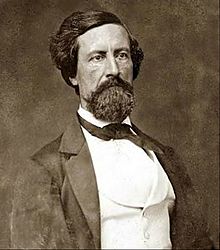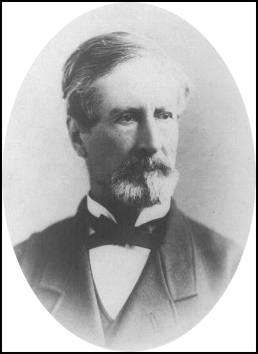John C. Pemberton facts for kids
Quick facts for kids
John Clifford Pemberton
|
|
|---|---|
 |
|
| Born | August 10, 1814 Philadelphia, Pennsylvania, U.S. |
| Died | July 13, 1881 (aged 66) Penllyn, Pennsylvania, U.S. |
| Place of burial |
Laurel Hill Cemetery, Philadelphia, Pennsylvania, U.S.
|
| Allegiance | |
| Service/ |
|
| Years of service | 1837–61 (USA) 1861–65 (CSA) |
| Rank | |
| Commands held | Army of Mississippi |
| Battles/wars | |
| Spouse(s) | Martha Thompson |
John Clifford Pemberton (born August 10, 1814 – died July 13, 1881) was an American soldier. He served as an officer in the United States Army for many years. He fought in the Seminole Wars and was recognized for his bravery in the Mexican–American War.
When the American Civil War began, Pemberton chose to join the Confederate States Army. He became a lieutenant-general and led the Army of Mississippi. He is most famous for being the commanding officer who surrendered during the Siege of Vicksburg. This was a very important event in the Civil War.
Contents
Early Life and Military Start
John Clifford Pemberton was born in Philadelphia, Pennsylvania. He was the second child of John and Rebecca Clifford Pemberton. In 1833, he started at the United States Military Academy in West Point. He was good friends with George G. Meade, who would later be a Union general.
Pemberton finished West Point in 1837, ranking 27th in his class. He became a second lieutenant in the 4th U.S. Artillery Regiment. He fought against the Seminole Indian tribe in Florida during the Second Seminole War. One of his battles was the Battle of Loxahatchee in 1838.
After that, Pemberton served in different places. He was stationed at Fort Columbus in New York and near Trenton, New Jersey. He also served along the U.S. border with Canada during a short conflict called the Canadian Border Disturbances. He was promoted to first lieutenant in 1842.
Serving in the Mexican-American War
From 1845 to 1846, Pemberton was part of the U.S. military in Texas. Then, he was sent to Mexico when the Mexican–American War began in 1846. He fought in several important battles. These included the Battle of Palo Alto and the Battle of Resaca de la Palma.
He also fought bravely at the Battle of Monterrey. For his actions there, he was given the honorary rank of brevet captain. In 1847, he continued fighting in Mexico. He was at the Siege of Vera Cruz and the Battle of Cerro Gordo. He also fought in the Battle of Churubusco.
Pemberton earned another honorary rank, major, for his performance at the Battle of Molino del Rey. He was wounded during the attack on Chapultepec Castle. During this war, he served with Ulysses S. Grant, who would later be his opponent in the Civil War.
After the Mexican-American War
In 1848, Pemberton married Martha Thompson from Norfolk, Virginia.
After the war, Pemberton continued his military service. He was stationed at Fort Pickens in Florida and fought against the Seminoles again. He was promoted to captain in 1850. He served in various forts, including Fort Washington, Maryland, and Fort Hamilton, New York.
He also participated in the Utah War in 1858. In 1861, he was in command of a regiment passing through Baltimore. This was during the "Pratt Street Riots", a violent event at the start of the Civil War.
Joining the Civil War
When the American Civil War started in 1861, John Pemberton faced a tough choice. Even though he was born in the North, he decided to resign from the Union Army. He joined the Confederate cause. His wife was from Virginia, and he had served many years in Southern states.
He officially left the U.S. Army on April 29, 1861. He quickly rose through the ranks in the Confederate Army. He became a lieutenant colonel, then a colonel. By June 1861, he was promoted to brigadier general.
In January 1862, Pemberton became a major general. He was given command of the Confederate Department of South Carolina and Georgia. However, he had a difficult personality. The governors of these states asked Confederate President Jefferson Davis to remove him. They also didn't trust him because he was from the North.
Davis then sent Pemberton to the West. He was assigned to a new department in Mississippi.
Defending Vicksburg
On October 10, 1862, Pemberton was promoted to lieutenant general. His new job was to defend the important city of Vicksburg, Mississippi. Vicksburg was key because it controlled the Mississippi River. President Davis told him that defending these states was his main goal.
Pemberton had fewer than 50,000 soldiers. He faced his former Mexican War colleague, the Union commander Maj. Gen. Ulysses S. Grant. Grant had over 70,000 Union soldiers in the Vicksburg Campaign.
Pemberton tried to follow orders from President Davis and General Joseph E. Johnston. He moved his Army of Mississippi to meet Johnston's forces. But a change in orders caused confusion. Pemberton's army accidentally met Grant's army at the Battle of Champion Hill on May 16. The Confederates suffered a major defeat.
Pemberton retreated to the Big Black River. There, his army suffered even more heavy losses on May 17. Pemberton decided to defend Vicksburg itself. He led his defeated men back into the city's defenses on May 18. He refused to abandon the city, even though Johnston advised him to save his army. Pemberton likely feared being seen as a traitor if he gave up Vicksburg.

The Siege of Vicksburg lasted over six weeks. Soldiers and civilians inside the city faced starvation. On July 2, 1863, Pemberton asked his commanders if their men could escape. They all said no. The next day, Pemberton asked Grant for a ceasefire to discuss surrender terms.
On July 4, 1863, Pemberton surrendered Vicksburg and his army to Grant. He surrendered over 29,000 officers and men, along with many cannons and rifles. This surrender, combined with the fall of Port Hudson, Louisiana, gave the Union full control of the Mississippi River. This was a huge loss for the Confederacy.
After his surrender, Pemberton was exchanged as a prisoner in October 1863. He returned to Richmond but had no assignment for months. He even wrote to President Davis asking to return to duty.
Pemberton resigned as a general officer in May 1864. Davis then offered him a lower rank, lieutenant colonel of artillery, which he accepted. This showed his loyalty to the South. He commanded the artillery defending Richmond until January 1865. He was captured in Salisbury, North Carolina, in April 1865, near the end of the war.
Life After the War
After the Civil War, Pemberton lived on his farm near Warrenton, Virginia. He had disagreements with General Johnston about the Vicksburg campaign.
A few years after his mother's death, Pemberton returned to Pennsylvania. He died in Lower Gwynedd Township, Montgomery County, Pennsylvania on July 13, 1881. He was buried at Laurel Hill Cemetery in Philadelphia, where his parents were buried. Some families protested his burial there because he had fought for the Confederacy.
A statue of John C. Pemberton stands in the Vicksburg National Military Park. His grandson, also named John C. Pemberton, wrote a book about his grandfather's defense of Vicksburg.
See also
 In Spanish: John C. Pemberton para niños
In Spanish: John C. Pemberton para niños



